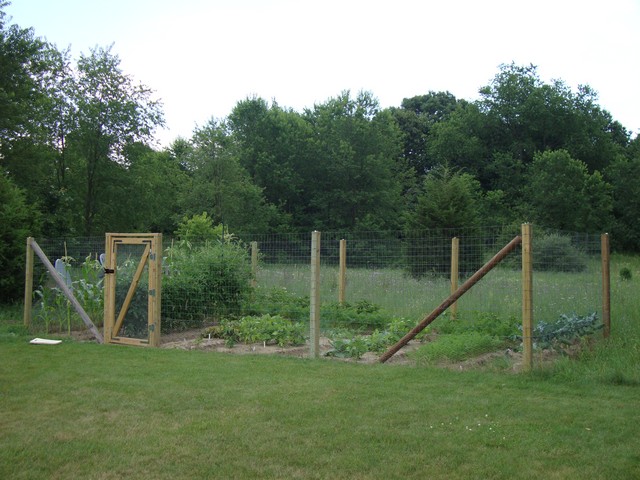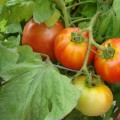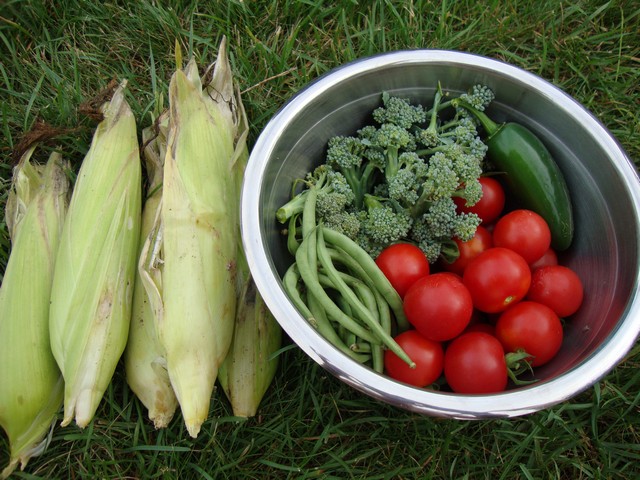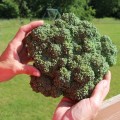
To keep a vegetable garden thriving during an extended vacation away from home can seem like a daunting task. Summer of 2011 was going to be a challenge; I realized that as soon as we started planning our much longed-for vacation to Norway, the country of my birth. Not only would we be leaving the country, unable to care for our garden, but we were going to be away for 3 1/2 weeks, as we were to leave on July 10, and not return until the beginning of August! That’s a long time to be away from a garden, and it meant we would be gone during a time that many vegetables would be ready to harvest, or need upkeep. In addition, it seems weeds are at an all-time high in July, not to mention dry spells and hot weather to make for high watering requirements. It was a tricky decision to make, as to whether I should attempt a garden at all that summer. The choice was between having no garden at all, even though we would be home almost the entire season, or to do very heavy planning and go for it, realizing that we still might be in for a lot of problems and failed crops. I decided on the latter, figuring that even if only some plants made it and produced, it would be worth it. I wanted to give it a try, at least.
There were a lot of things to take into consideration. I did not want to burden anyone with a lot of work, so I had to plan carefully to make sure the needs would be at an absolute minimum. That meant we needed to install an automatic watering system, make sure as few plants as possible would need harvesting in that time period, apply organic pest control immediately before leaving, place support and staking for growing branches and tomato plants, put in place some weed control, and still find someone to check things over now and again and harvest the few things that were beyond my control. A lot of planning and thinking ahead was needed.
Though there would be a need for occasional manual watering, my husband installed an automatic watering system that in all reality was quite simple and inexpensive, (compared to underground sprinkling!) but very effective and helpful. He purchased an outdoor faucet timer that allowed for different settings, and installed it directly on the faucet with a hose attached. The faucet would be turned to the “on” position the entire time, but with a timer attached would only let out water at specific times. On the other end of the hose, in the garden, was a regular lawn sprinkler that would water the garden whenever it turned on. This system was a great help, supplying a lot of plants with the water necessary while we were gone, keeping manual watering needs to a minimum. It wasn’t a perfect system, as some plants grew very large and blocking other plants from getting enough water, and some spots were not covered very well because the sprinkler wasn’t able to reach every corner. But it still made it possible to get away with only an occasional extra watering to cover the rest.
Here’s the timer he purchased at Amazon: Orbit 62061N Single-Dial Water Timer
This device was very simple to use, and worked very well for the purpose we needed it for. Regarding programming, the instructions were easy to follow, and we could decide when it should turn on, how long it should run, and how often. That’s it. And now that we own it, we use it when we’re home too at times, although there are plants that are sensitive to overhead watering (like tomatoes and broccoli) so it’s best to be a bit cautious. But for us, it gave us an opportunity have a garden in spite of leaving for a vacation.
The lawn sprinkler we used was one similar to this one from Amazon: Melnor Sprinkler
Regarding planting, it was important that I planted everything at the right time. Some plants, such as tomatoes and peppers, should be planted as soon as the danger of frost is over, in order to grow large and strong. I had to expect that some tomatoes would start to ripen while I was away, for someone else to harvest. But there would be more waiting when we got back, so they were worth planting.
Vegetables such as green beans and carrots, on the other hand, needed to be planted with a plan in mind. These veggies are much more flexible as to when you can plant them. Since I wanted them to produce for me as soon as possible after we arrived back home again, but not while we were away, I had to make sure not to plant these too early. Otherwise it would defeat the purpose of planting them for our use, and it would also mean a lot of extra work for someone else to deal with. So I had to make sure to plant them with that in mind. I planned for them to be ready about one week after our return from Norway, and it turned out the beans had been so happy with me gone that they were ready for harvest several days early! That would have been OK had it not been for the number of plants I had planted! I came home to see an entire forest of plants and beans, and the sight was absolutely overwhelming! I had a huge job of picking, cutting, blanching, and freezing in front of me, a process that would keep on going for a while. We had piles and piles of beans; there were so many that when Mexican beetles attacked, I wasn’t all that sorry! I can’t believe I’m saying that… Needless to say, I won’t be planting nearly as many plants this coming season. With each vegetable, I would look at the seed packets or plant tags for when the various plants would be ready for harvest after planting, and plan accordingly.
Weeding was definitely a concern; when I thought about how quickly weeds can get out of control, how in the world could this be handled? I did NOT want anyone to have to come constantly to weed my garden, so I decided to do what I could, then leave the rest alone pretty much, and hope for the best. To help the situation somewhat, I put a thick layer of grass clippings on the floor of the entire garden, both between the plants and on the paths between the rows. Using grass clippings as mulch helps to keep a lot of weeds at bay, and will serve as compost as it rots. It also helps to retain moisture. And, of course, grass clippings are free, so it only made sense to use it. When we came back, there were definitely a whole lot of weeds around still, despite the grass clippings, but they hadn’t smothered any of the plants. Though I didn’t like the looks of my garden with so many weeds around, I still felt it was mostly cosmetic and not a real threat to the plants, even though weeds do compete for both water and nutrition. All in all it still had worked out. There were too many weeds to start pulling it all when we came back, so I went for the largest ones and left the rest alone.
I also hired one of the kids from the neighborhood to come and look things over now and again; she would pull at the largest and most invasive of the weeds, then per my request ignore the rest, water when necessary, and make sure things were somewhat under control. Her father would come by too, occasionally, to look things over. And they would harvest whatever was needed. The job, turned out, was nothing overwhelming; things had gone smoothly and all the planning had payed off.
Pest control can be needed at times, and I couldn’t be there to keep an eye on that, being that I was on vacation. Since I had found Spinosad to be quite helpful in controlling insect pests, in addition to being safe for humans and fine to use for organic gardening, I applied it on the most susceptible plants right before leaving. Then I reapplied it when I came back home again. The only problem was that a lot of plants grew a lot in that time period, and the new growth was of course untreated. With the exception of Mexican bean beetles, I did not have any significant problems with insect pests.
This is the spinosad concentrate that I use:
Normally I would have applied a copper fungicide on my tomato plants in addition (also safe and OK for organic gardening), for fungal disease such as early blight, before leaving on such an extensive trip. Some circumstances prevented me from being able to do that this time, and when we came back, the results were pretty obvious; my tomato plants were, in fact, infected with early blight, and were looking quite pathetic. Early blight is fortunately not nearly as bad as late blight, which can kill a plant very quickly. Early blight is unsightly, and will cause branches and leaves to slowly die. This, in return, can affect the yield of tomatoes, size, or cause sun scalding of fruits because of the lack of leaves to protect them. Still, being that early blight starts at the bottom of the plant and moves slowly upward, often allowing for some new growth toward the top of the plants, my plants still produced a ton of tomatoes altogether, and certainly more than we could use. Regardless, because this copper spray needs to be reapplied after heavy rains, I still may not have seen any benefits with using it, since I couldn’t reapply while I was away on my trip anyway. So in all reality, it may not have made much of a difference this time around.
This is the copper dust, which is to be mixed with water, that I usually use for my tomato plants:
One of the last things I did before leaving for our vacation, was to stake the pepper plants and tomato plants; the tomato plants were in cages already, but still needed some looping through of longer branches and tying up here and there. When we came back home again, they had grown a lot, and needed to be tied up again, against the 8-foot rods I had put in place earlier; some of the branches were really drooping down, and the situation wasn’t ideal. But the tomatoes were still happy.
All in all, with my careful planning, things had worked out better than expected, with high yields of different vegetables despite us being away for such a long time. I will not hesitate doing this again, especially when the alternative is to have no garden at all.





VERY helpful!
Thanks was very helpful.